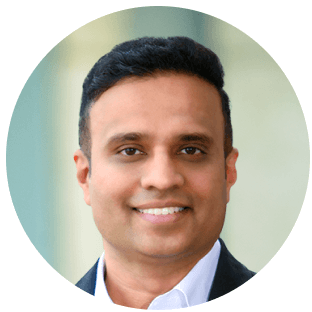Starting a company from scratch is always a gutsy move. A lot of things have to fall in place for a startup to take off. It takes conviction, competence, courage and loads of tenacity. Successes are sweet but there are many learnings. As we celebrate six years of Fortanix as a company, and the recent funding milestone, I had a chance to sit down with Ambuj and Anand and explore road travelled thus far and their vision for the road ahead.
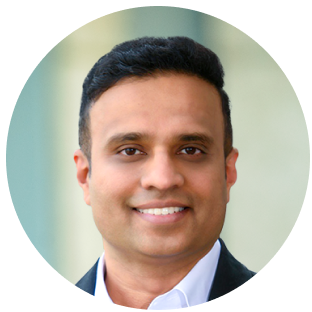
Congratulations on six years of Fortanix! How would you describe the journey so far?
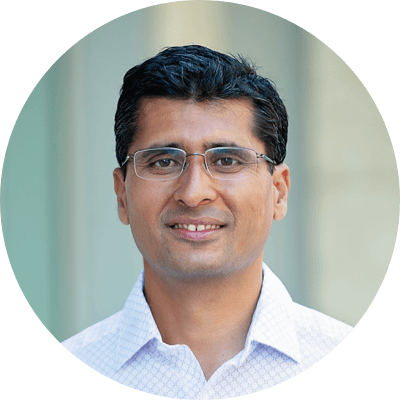
When we started, the notion that we could keep data secure, wherever it goes was called a pipe dream. At that time, the focus and investment were mostly around securing infrastructure and being breached was almost the norm. We turned that notion around on its head and in the process helped create this category of confidential computing. This has now become mainstream with over a hundred global enterprise customers onboard and hundreds more in the pipeline. It has been an amazing journey!
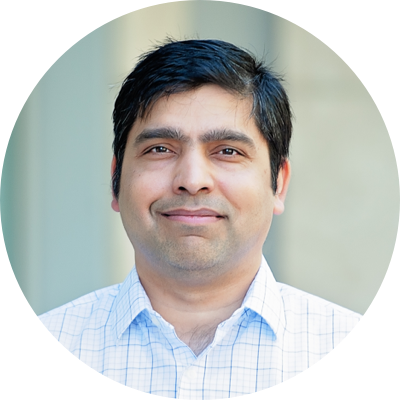
It’s hard to believe that it’s already been six years. It still feels like we are getting started and there is so much to do. Having said that, we have come a long way. Like any startup, we have had several twists and turns in the journey. While converting an idea into a product that could be sold with a real market applicability has been amazing, dealing with the uncertainty at the beginning of the pandemic was initially challenging. We are also fortunate that a few things have remained unchanged over the past 6 years. For example, the initial idea of building a platform powered by confidential computing is still driving the company’s vision; our founding team is still going strong, and the pace of growth of the team and the business has been consistent and fast paced. We look forward to continuing the journey for the next six years.

Let’s turn the clock back to six or seven years ago. You both knew each other as classmates at undergrad but then went different ways. What brought you back together and whose idea was it to form a company?

Anand and I have known each other for nearly half our lives as we were together as undergrads. We lost touch for quite a while and then when we came together in the bay area, the ideas and discussions naturally began. We had both coincidentally in the security space, with me focused more on encryption and he on systems security and software. We were both curious, first-principle-driven based people and debated about how to secure data which in our mind was a top-order problem to solve when everyone else was focused on securing infrastructure. We thought we could boil down security hacks into simpler equations and get to the point of exclusivity. For example, if we took the operating system and root users out of the trust equation, then perhaps we could keep data secure even if everything else fell apart. Founders have to have inherent trust in each other. Starting a company can have its fair share of setbacks and having someone that you can trust without having to watch your back is a big deal. That came naturally to both of us.


Let me tell you my side of the story. After graduating from college, I got a PhD in Computer Science, working in computer networking and then worked at Symantec as a researcher focusing on security and networking. I was working at another startup when I reconnected with Ambuj, and we started brainstorming ideas for a startup. We had both gained extensive experience in the security industry and had seen first-hand how ineffective traditional security solutions had become in stopping data breaches. Most of them were just using pattern matching or machine learning to stop the attacks on the infrastructure, while the attackers were going directly to the data. Digital transformation was driving cloud adoption at a rapid rate and again the traditional approaches were inadequate to deal with that. With Ambuj’s experience in hardware security and cryptography coupled with my deep background in software and cloud security, we quickly realized we had the ideal background to secure data in the cloud with hardware-based security, which eventually laid the foundation for confidential computing. Validating this idea and building a company around it warranted multiple sessions of ideation and brainstorming.

Was it easy taking the plunge? Both of you were in good positions in your respective companies. What was the thought process?

In hindsight, I should have taken the plunge sooner. First off, I was very fortunate to work at Nvidia, where I was perhaps their 500th employee or so. Today, they are over 20,000. I had an opportunity to work with Jen-Hsun and other leaders, observing them at close quarters. This definitely inspired me and gave me the confidence to act on my own intuition. Security was a big market, and I had seen other companies be created from scratch. The dream was to do something similar. The thinking was that if this conviction did not work out, then I could always find another job. That’s the beauty of working in Silicon Valley. Of course, it helped that my spouse was working as well, which added an extra layer of security for the family.

There were a few catalysts. When I look back, the primary driver appears to be the apathy we saw in the industry. It appeared that the prevailing feeling in the industry was that cyber-attacks would happen. It was a question of when, not if. It appeared that the industry had already resigned in defeat. After working in the security industry for seven years, I was disheartened by this attitude. Ambuj and I felt that we could change that. We believed then (as we still believe now) that the security solutions we could build could change this perception. We had a firm conviction in our understanding of the problem and the merits of our solution. Together, we believed we could seriously challenge the status quo. The strength of this conviction made it quite easy to take the plunge. Next, being in a large company was never as attractive as building something game changing from scratch. Being in control of our own destiny while doing that was too tempting to resist.

You quit your jobs. Then what happens? Now you need money. How did you get someone to back you?

There were several lessons. Founders often try to convince investors, who sometimes back companies based on what some analysts, social media or newspapers say. Nobody other than the founder has the fundamental insight into their idea. Raising money cannot be a substitute for the fundamental validation of an idea. This is where Anand and I worked from first principles. Our goal was to make sure that the problems we were solving and the solutions we created were all meaningful and differentiated. Once we went through this exercise deeply, we made the usual Silicon Valley road trip connecting with investors via friends and getting referral introductions. As a first-time founder, we probably had to pitch to 50 investors before the 51st decided to place a bet on us.

The first step was to raise a small seed round of funding, which would allow us to build the product and hit the milestones to raise the next round of funding. We leveraged our network of friends, advisers, ex-colleagues, and alumni to reach out to VCs who invest in early-stage startups. Our pitch was quite bold and unique, and that helped us in attracting interest from multiple VCs. After a few (or quite a few) investor pitches, we got a few investors interested in us, and we chose the one we liked the best!

How did you decide who gets to be the CEO or CTO? I imagine you were wearing a lot of hats starting out. What was the division of responsibilities early on?

I don’t remember having this discussion. All I would say is that the smarter person becomes the CTO, and I’ll leave it at that.
 The Early Team
The Early Team
This was never explicitly discussed between us. During the entire ideation process, and later the fund-raising process, we were very clear on who will take on the CEO and CTO roles. I believe this was due to the natural inclination that each of us had towards the responsibilities of each role. In the initial stages, the CEO takes the primary responsibility of managing investor relations and laying the groundwork for GTM activities, while the CTO takes the primary responsibility of product development and engineering. Product management and hiring of early technical employees was a shared responsibility of both founders.

Both of you came from deep technical backgrounds. Was it a steep learning curve to suddenly wear a business hat? What were some of the early mistakes and learnings in making this transition?

I always work from first principles. Curiosity has been a constant trait. Whether it be transistors or the cloud, or whether it be product capabilities, I try to get into questions on why we are creating something, how our customers use it and more importantly ask why? There is a whole debate about vitamin pills vs. Pain killers. The world is always rooting for heroes! People come out of the woodwork to support you if you offer great insight to address a genuine problem.

It’s definitely a steep learning curve and we have both been learning on the job. However, business, and specifically the business of startups is best learnt through experience and not in a classroom. We have made several mistakes. However, in the early days, the stakes are low, and the cost of making a mistake is low. If you keep learning from your mistakes, and don’t repeat them, you will minimize the impact of mistakes when the stakes are high.

Today, we are over 220 people across multiple countries. But starting out, how did you attract the first set of employees?

Hiring at an early stage is quite tough, but I also recall it being a fun phase. There is no product, nor customers. The Equity is worthless. Yet, our expectations are high – to attract world-class talented engineers to join us. For first time founders – this is tough, but we had high standards, and it took us almost three months to hire our first engineer. We must kiss a lot of frogs before finding the prince. But fortunately, there are engineers out there who have equally high standards on the problems they want to work on and who share the vision of changing the world. Once we find that specific profile, magic happens.We have since kept a similar mindset in hiring our employees. Even as we have grown bigger as a company, I believe the bar to join Fortanix is still very hard.
 First office space in Castro Street,Mountain View
First office space in Castro Street,Mountain View
It was not easy as we had set a very high bar right from the beginning. Our first set of employees were mostly engineers and designers. We were looking for experience, ability, and skill in relevant areas. As soon as we raised your first round of funding, the clock started ticking, and there was pressure to move to the next milestone. The most important part is then to build the team. We took this role very seriously. After raising our seed round, Ambuj and I became full-time recruiters. We leveraged our network, sent hundreds of cold emails on LinkedIn, and hustled! We were still very intentional in our process and interviewed over 100 candidates in 3 months before making our first hire.

How did you land your first customer?

I believe the world is always rooting for heroes and underdogs. There are bad people misusing data in various forms, including cross-border terrorism, human trafficking, and money laundering – all of these have generated a lot of sensitivity and anger, and rightfully so. So, when the right-minded see a promising solution that can genuinely prevent such happenings, they aspire to believe in that vision. We talked to many prospects and pitched to anybody who would listen. At times, we were just educating people. A few of them took a genuine interest and surprisingly, one of them gave us a purchase order! That customer is still with us. They have continued to expand, and we have kept them happy. I’m really grateful to them.
 Celebrating early successes
Celebrating early successes
As a startup, we must always hustle. We had hired our first BD person, and we were sending cold emails to prospects, meeting as many prospects as we could to tell them our story, and we were leveraging our network as well as the network of our VCs and advisers to get in front of as many potential customers as we could. Our hustle paid off and we got lucky. One of our cold emails landed in front of the CISO of one of the largest financial institutions in the world, who was running an RFP to select the next enterprise-wide data security solution.
She was at the final stages of the vendor selection process but wasn’t very happy with the choices presented to her. She liked the promise and the zest in our cold email and decided to give us a chance. She told her team to evaluate our product too as part of the RFP. When we received the RFP, our product didn’t satisfy most of the requirements being asked of. However, we again hustled. We worked day and night and implemented several features in a matter of days which made our product competitive compared to the other products. We then did a great presentation to show the vision and won them over. They have grown to be one of our largest customers, and we will eternally be grateful to them for the trust they placed in us early on.
She was at the final stages of the vendor selection process but wasn’t very happy with the choices presented to her. She liked the promise and the zest in our cold email and decided to give us a chance. She told her team to evaluate our product too as part of the RFP. When we received the RFP, our product didn’t satisfy most of the requirements being asked of. However, we again hustled. We worked day and night and implemented several features in a matter of days which made our product competitive compared to the other products. We then did a great presentation to show the vision and won them over. They have grown to be one of our largest customers, and we will eternally be grateful to them for the trust they placed in us early on.

Today, Fortanix has over 100 big name enterprise customers, including some of the largest global banks, federal agencies, public cloud providers, payment processing companies and many others. Do you feel you’ve realized the founding vision, and how do you see this evolving over the coming years?

Our vision to decouple security from infrastructure, to enable our customers to fully unlock the potential of their data without or despite getting breached, hasn’t changed at all. We have made a lot of inroads, but there’s continued ground to cover on fulfilling that vision in its entirety.

Our vision was to solve for data security and privacy in the cloud. The opportunity is so large that we are still scratching the surface. It’s amazing to see the product in use at some of the largest enterprises in the world, but we still have a long way to go. Most enterprises are data-driven these days, and securing that data is of utmost importance. We want to become a one-stop-shop for data security that any enterprise would deploy and appeal to different buying centers. Today, customers are presented with a buffet of security solutions to address their needs, but they fall short in their capabilities, and too many fragmented solutions create complexity. We want to replace all those tools with a comprehensive data security platform that is simple, easy-to-use and deployable for a variety of modern use-cases

Talk to me about the role your families played in your journey so far, particularly your spouses

Even when I wasn’t a founder, I used to bring work home. To a large extent, my personal and professional lives have always been intertwined. As a founder the days are longer, and the stress level can be higher. I’m certainly thankful to my family for coping with me. To maintain balance, I try to dedicate 100% of my weekdays to work and 100% of my weekends to the family.

The early stages of a startup are very demanding on time and are quite stressful. I’ve been blessed to have the support of my spouse and my two young children to keep me grounded and reduce the stress. My younger child is almost the same age as Fortanix, and it has been great to draw parallels between him and the company as they passed the stages of infancy to being a toddler, and now to be able to stand on their feet confidently. Building Fortanix would have been impossible to do without the constant support and numerous sacrifices made by my wife, and I am eternally grateful to her for that.

Looking back, do you feel you have achieved success? What defines success for you both personally and for the company at large?

If our customers could take their sensitive data anywhere, share it or analyze it without the fear of getting breached, to the cloud or elsewhere, for any number of use-cases, that would be the true success for us. This can also extend to nation states where we can ensure they cannot have access to sensitive industrial systems, citizen data, etc., no matter what. We are barely scratching the surface on these, but our direction and momentum are absolutely on the right track.

Success for me means success for our employees and success for our customers. Some of our employees have started their careers at Fortanix and have developed into confident and self-assured leaders who will do great things in their lives. Seeing them become successful gives me immense joy and satisfaction. Similarly, I am deeply proud of our zeal at Fortanix to build great products that make our customers’ lives easy. Seeing them achieve success and growth, saving costs, and having a delightful experience using our product gives me great satisfaction as well. I believe that the success of the company can also be defined based on the success of our employees and customers.

As co-founders, how would you describe the culture you both have built?

Our trait for culture is excellence. We like working with people who have a great sense of ownership, and like creating things that are superior to anything else that has been created before. These are the people that feel the universe requires a new solution and are itching to make a dent in it. We foster such an environment and instil that in our co-workers.
 New executives join the round table
New executives join the round table
I strongly believe in Ben Horowitz’s words that culture is not what you say but what you do. We have a high-performance and fast-paced culture, where we expect everyone to be super responsive, and be doing the best work of their careers. We also have a very collaborative culture where everyone is eager to help their colleagues. We encourage a strong sense of ownership and accountability in people’s actions, whether it be executives or individual contributors.

For prospective employees considering Fortanix, why should they join this company versus all the other opportunities out there?

Most Fortanix employees indeed have turned down several offers elsewhere. They certainly have a choice. Fortanix can become a multi-generational company, and many have the opportunity to do some of the best work of their career here. Working with some of the best people around, can also be incredibly uplifting in terms of ideas and discussions, defining new possibilities for individuals and the company at large. So, my invitation to prospective employees is to come and experience the challenge and benefit from the incredible opportunity.

Prospective employees should do their independent research on Fortanix. Then they should talk to some of our employees and if possible, talk to some of our customers or partners. Great employees want to work at great companies with great colleagues. They want to learn from their peers, and they want them to be the best. I believe Fortanix gives them that platform. Some of our best hires came from referrals.
 Horsing around in the park at a company picnic
Horsing around in the park at a company picnic
Fortanix in 5 years?

I would like for us to become a household name, at least in the businesses we are relevant to. Data security should be mainstream, and no one should be asking if they need to secure infrastructure to secure data. Anyone should be able to secure data, wherever it is.

Fortanix in 5 years will be a large, independent, and meaningful security company, and It would be recognized as the de-facto platform for data security in any enterprise.

And now the new Series C- funding of $90M. Cherry on top?

Yes, it is a great validation of our strategy and the huge opportunity ahead of us and we have some amazing investors backing us. As I told the team, more money comes with greater responsibility. The expectations are higher, and our execution must be world-class. We will work harder and work smarter. The market is ours to take. Next stop - $100M ARR!

Funding is just a pitstop. Our journey continues. Onward and upward!
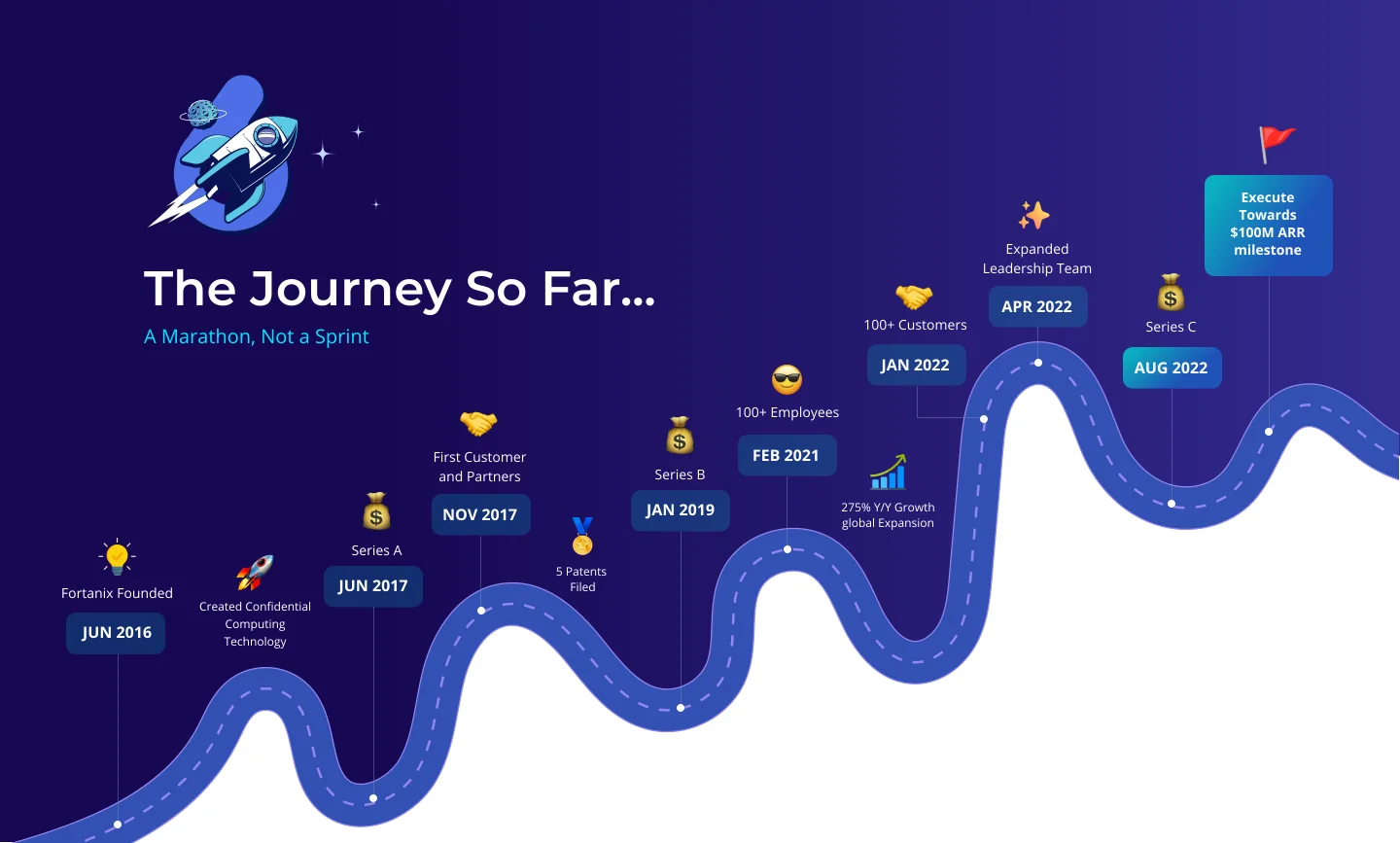
Additional Resources:
- Read Fortanix CEO Ambuj Kumar’s Series C announcement blog
- Read our Press Release: Fortanix Raises $90M in Series C Funding Led by Goldman Sachs Asset Management to Accelerate Leadership in the Data Security Market
- Explore a new approach to enterprise data security on the Intel Capital blog
- Read this blog post from Neotribe Ventures
- Check out this latest blog from Foundation Capital: Fortanix Raises $90M Series C
- Cloud Security Journey: from Ridiculous to Mainstream to Ridiculous
- Life at Fortanix
Share this post:

